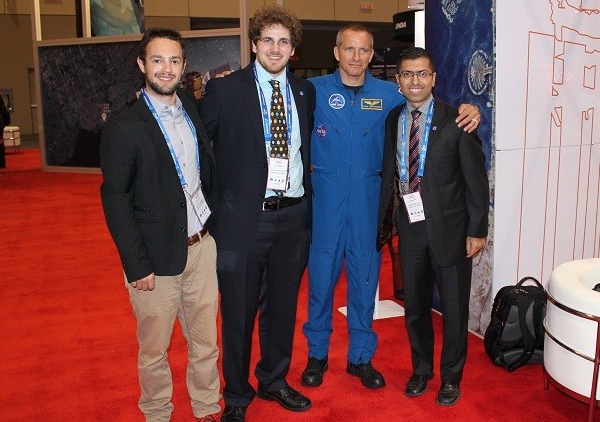Space Concordia, the award-winning student association that works on satellites and rockets, is always on the move, and 2014 has been no exception.
Over the past four years, Space Concordia has been developing its first CubeSat (the name given for a shoebox-sized satellite typically used for research purposes), named ConSat-1, which was the winner of the 2012 Canadian Satellite Design Challenge. ConSat-1 now needs to be made launch ready. This is no small task. Alfred Ng, a space industry expert and a manager at the Canadian Space Agency, is on board to provide some mentorship.
“He has dedicated considerable time to giving us help and advice at each of our monthly meetings,” says Svetlana Spitsina, the current team lead and a research associate at Concordia. “He is a remarkable man.”
To be ready, the satellite must pass numerous safety and regulatory requirements. Also, a ground system will be set up from which the students can monitor its progress once it is in space. Spitsina and her teammates are hopeful that ConSat-1 will be aboard a rocket some time in 2015. Once in space, ConSat-1 will study the South Atlantic Anomaly, an area of high radiation activity off the coast of South America.
Meanwhile, Space Concordia’s other satellite team is equally busy with their project, named Aleksandr, which has a very different mission. Aleksandr, with help from professor Suong Hoa, an engineering professor with decades of experience in the area of composite materials, is being readied for studying how self-healing material holds up against space debris.
More than 90 per cent of impacts in Low Earth Orbit are caused by micrometeoroids and orbital debris which can lead to damage and malfunctions. The self-healing process would use composites with healing microcapsules and a catalyst embedded within the resin.
When damage occurs, the microcapsules release a healing agent which rapidly solidifies throughout the fracture. While the process is well-documented on earth, it has yet to be tested in space. If results of this experiment are successful, future spacecraft could benefit from using a self- healing shield.
In November 2013, Space Concordia was successful in raising $15,000 toward this project via the online crowdsourcing platform, Kickstarter. Contributions came from hundreds of donors, including a large $3,700 gift from Nick in Russia, who was then asked to name the satellite. That’s why the satellite bears he name Aleksandr, in memory of Nick’s late father. Aleksandr went on to place second in the 2014 Canadian Satellite Design Challenge, the final phase of which was adjudicated at Ottawa’s David Florida Laboratory, part of the Canadian Space Agency. The results were announced May 30, 2014.
Rubbing Shoulders With the Space Elite
For the first time in its history, Space Concordia was invited this year to the prestigious International Astronautical Congress (IAC), which was held in Toronto, September 29 to October 3. They presented Aleksandr and explained the objectives of their project.
“IAC is the world’s premier space event, where all major space players attend,” said Mehdi Sabzalian, Aleksandr’s team lead. This year, that VIP list included Canadian astronauts Chris Hadfield, Jeremy Hansen, David Saint-Jacques, Marc Garneau, as well as the former President of the Canadian Space Agency, General Walter Natynczyk, NASA’s administrator, Charles Bolden, and European Space Agency Administrator, Jean-Jacques Dordain.
“It was a great opportunity for all of us to network and show this community Concordia University’s presence in the space scene,” says Sabzalian. Just a few weeks later, General Natynczyk visited Concordia to learn more about Space Concordia and the university’s space-industry related facilities, research, and course offerings.
Space Concordia’s faculty advisor, professor Nadia Bhuiyan, is delighted with the association’s progress. “They are making great leaps forward in their understanding of how the industry works and how to work in teams on projects that are technically very rigorous and demanding,” she said. “I sense a very bright future for these students!”
Three More Space Concordia Projects Take Flight
Modular Assembly Satellite Standard (MASS) – is a project that will provide other aspiring satellite builders with a platform where they can build their
own CubeSats using open
source design.
Intercollegiate Rocket Engineering Competition – a team is assembling a rocket to compete in Utah in the summer of 2015.
University Rover Challenge – students are working hard to finish building a Mars Rover, a tough all-terrain vehicle capable of travel and various mechanical functions on other planet. It too will compete in Utah in 2015.
